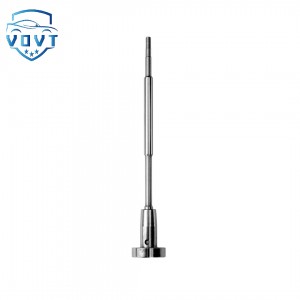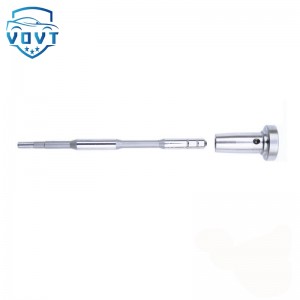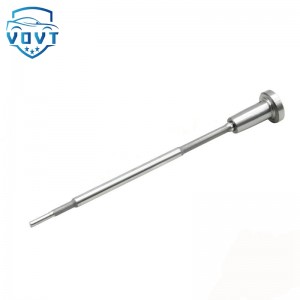High Precision New Diesel Injector Control Valve F00RC00351 Valve Assembly for Fuel Injector Engine Spare Parts
Products Description
| Reference Codes | F00RC00351 |
| Application | / |
| MOQ | 6 PCS |
| Certification | ISO9001 |
| Place of Origin | China |
| Packaging | Neutral packing |
| Quality Control | 100% tested before shipment |
| Lead time | 7~10 working days |
| Payment | T/T, L/C, Paypal, Western Union, MoneyGram or as your requirement |
Research on key technologies and performance optimization of injector valve components
The injector valve assembly is the core component of the injector and plays a decisive role in the performance of the fuel injection system. This article details the structure, operating principle, and key technical indicators of the injector valve assembly, explores performance optimization strategies, and provides an outlook on future development trends, providing theoretical support for the technological upgrade and efficient application of the injector valve assembly.
I. Introduction
As engines strive for efficient and clean combustion, the injector valve assembly, as the key to precise fuel injection control, is crucial for improving its performance. It directly affects fuel atomization, injection volume accuracy, and the engine's power, fuel economy, and emissions, making it a core factor driving engine technological advancement.
II. Injector Valve Assembly Structure and Operating Principle
2.1 Structural Components
The injector valve assembly primarily consists of a needle valve, needle valve body, spring, armature, and solenoid coil. The needle valve and needle valve body form a high-precision mating component with a micron-level clearance (typically 3-5μm). Their precise coordination controls the on and off of fuel injection. The spring provides closing force for the needle valve, ensuring it seals tightly against the valve body during non-injection periods, preventing fuel leakage. The armature and solenoid coil work together. When the solenoid coil is energized, it generates a magnetic field that attracts the armature, forcing the needle valve upward against the spring force, opening the injection port.
2.2 Operating Principle
The operating process consists of three phases: opening, injection, and closing. During the opening phase, the engine control unit (ECU) issues an injection command. Current flows through the solenoid coil, generating a strong electromagnetic force that attracts the armature and moves the needle valve upward, opening the injection port and initiating high-pressure fuel injection. During the injection phase, fuel is continuously sprayed under high pressure. Injection parameters (such as injection volume and injection rate) are determined by the injector valve assembly structure and the ECU control strategy. During the closing phase, the ECU de-energizes the solenoid coil, dissipating the magnetic field. The needle valve rapidly returns under the force of the spring, closing the injection port and terminating fuel injection.
III. Key Technical Indicators
3.1 Injection Accuracy
3.1.1 Injection Quantity Accuracy
Injection quantity accuracy is affected by multiple factors, including the clearance between the needle valve and the needle valve body, nozzle hole dimensional accuracy, fuel pressure stability, and solenoid control accuracy. Excessive clearance can lead to fuel leakage, causing the actual injection quantity to fall below the set value. Deviations in nozzle hole dimensions can alter the fuel flow area, thereby affecting injection quantity. Research has shown that a nozzle hole diameter deviation of ±0.01mm can result in injection quantity deviations of up to ±5%. In high-pressure common rail systems, high-precision machining processes and advanced pressure control technology can achieve injection quantity accuracy within ±1%.
3.1.2 Injection Timing Accuracy
Injection timing accuracy is primarily determined by the solenoid coil response speed, needle valve motion characteristics, and ECU control accuracy. Parameters such as the solenoid coil's inductance and resistance affect the current rise and fall times, which in turn influence the needle valve opening and closing timing. Needle valve quality, spring stiffness, and lubrication conditions also significantly influence injection timing. The use of a fast-response solenoid coil and optimized needle valve structure, combined with a precise ECU control algorithm, enables injection timing accuracy of ±0.5° C (crankshaft angle).
3.2 Atomization Performance
3.2.1 Atomized Particle Size
The nozzle structure and size significantly influence the atomized fuel particle size. A smaller nozzle diameter allows the fuel to break up into smaller droplets under high pressure, but too small nozzles are prone to clogging. For example, micro-hole (0.1-0.2mm diameter) injectors can achieve an average atomized fuel particle size of 10-20μm, significantly improving atomization performance compared to traditional nozzles (0.2-0.4mm diameter). Furthermore, increasing injection pressure can help reduce atomized particle size. In a high-pressure common rail system, increasing injection pressure from 100MPa to 200MPa can reduce atomized particle size by approximately 30%.
3.2.2 Spray Cone Angle
The spray cone angle is determined by the needle valve head shape and nozzle arrangement. An appropriate spray cone angle ensures even fuel distribution within the combustion chamber and thorough mixing with the air. In direct injection engines, the spray cone angle is typically between 60° and 120°, with the specific value optimized based on the combustion chamber geometry and air flow characteristics. A spray cone angle that is too large or too small will result in uneven mixing of fuel and air, affecting combustion efficiency and emissions performance.
3.3 Durability and Reliability
Injector valve assemblies operate in harsh environments of high temperature, high pressure, and high speed, placing extremely high demands on durability and reliability.
3.3.1 Material Selection
Needle valves and needle valve bodies are often made of high-hardness, wear-resistant alloys, such as tungsten- and molybdenum-containing alloy steels. Through quenching, tempering, and surface nitriding, surface hardness can reach HV900-1200, effectively improving wear resistance. Injector valve assemblies operating in high-temperature environments also require consideration of material thermal stability. Key components are manufactured from high-temperature alloys that can withstand temperatures of 300-500°C. 3.3.2 Wear and Corrosion
Impurities, moisture in the fuel, and acidic substances in combustion products can cause wear and corrosion of the injector valve assembly. Wear at the nozzle increases the nozzle diameter, affecting injection volume and atomization performance. Corrosion between the needle valve and the valve body damages the precise fit, leading to leakage. Optimizing the fuel filter's filtration accuracy to reduce impurity ingress and adding anti-corrosion additives to the fuel can effectively reduce wear and corrosion, extending the service life of the injector valve assembly. Surface coating technologies, such as chrome plating and nickel-phosphorus alloy plating, can also be used to improve surface hardness and corrosion resistance.
IV. Performance Optimization Strategies
4.1 Structural Parameter Optimization
Advanced simulation technology is used to optimize the structural parameters of the injector valve assembly. Multi-physics coupled simulation software, such as CFD (computational fluid dynamics), EM (electromagnetism), and structural mechanics, is used to simulate fuel flow, electromagnetic forces, and structural deformation during component operation. Simulation analysis of various structural parameters (such as nozzle diameter, needle valve lift, and number of turns in the solenoid coil) is performed to establish a model that relates these parameters to performance. For example, simulations have shown that reducing the nozzle diameter within a certain range significantly improves fuel atomization, but this increases fuel flow resistance, necessitating comprehensive optimization by considering factors such as injection pressure. Using the response surface methodology, a response surface model was constructed using key performance indicators of the injector valve assembly (such as injection quantity accuracy, atomized particle size, and response time) as response variables and structural parameters as design variables. An optimization algorithm was then used to determine the optimal structural parameter combination that met the performance requirements. Research has shown that optimization using the response surface methodology improved the injection quantity accuracy of the injector valve assembly by approximately 20% and reduced the atomized particle size by approximately 15%.
4.2 Material and Manufacturing Process Upgrades
4.2.1 Application of New Materials
The development and application of high-performance materials, such as ceramic-based composites for needle valves and needle valve bodies, are characterized by high hardness, wear resistance, and a low thermal expansion coefficient, enabling stable performance in high-temperature and high-pressure environments. In high-end injector valve assemblies, nanomaterial coatings, such as nanodiamond coatings, are being explored. These coatings can significantly improve surface hardness and lubricity, reduce friction, and minimize wear, extending the life of the injector valve assembly by 2-3 times.
4.2.2 Improving Precision Manufacturing Processes
Ultra-precision machining technologies, such as electron beam machining and ion beam machining, are being employed to further enhance the manufacturing precision of injector valve assemblies. These technologies can control the nozzle diameter accuracy to within ±0.001mm and the clearance between the needle valve and the needle valve body to 1-2μm, significantly improving the injection accuracy and sealing performance of the injector valve assembly. The introduction of 3D printing technology enables the integrated manufacturing of complex injector valve assemblies, optimizing internal flow channel design and improving fuel flow efficiency. For example, injector valve assemblies manufactured using 3D printing can reduce internal flow channel pressure loss by 10%-15%. 4.3 Integration of Intelligent Control and Monitoring Technologies
4.3.1 Application of Intelligent Control Algorithms
Advanced intelligent control algorithms, such as adaptive control and fuzzy control, are implemented in the ECU to dynamically adjust the injector valve assembly's injection quantity, injection timing, and injection pattern based on real-time engine operating conditions (such as speed, load, and temperature). Adaptive control algorithms automatically adjust injection parameters based on fuel quality and engine wear, ensuring optimal engine operation. Experimental results show that the implementation of intelligent control algorithms improves engine fuel economy by 5%-8% and significantly improves emissions performance.
4.3.2 Sensor Fusion and Fault Diagnosis
Multiple sensors, such as pressure sensors, temperature sensors, and displacement sensors, are integrated internally or externally into the injector valve assembly to monitor its operating status in real time. Sensor fusion technology comprehensively analyzes data from these multiple sensors to provide early warning and accurate diagnosis of injector valve assembly faults. For example, a pressure sensor can detect abnormal injection pressure fluctuations. Combined with needle valve motion information from a displacement sensor, this can quickly determine whether the fault is a blocked nozzle orifice or stuck needle valve, allowing timely action to improve engine reliability and availability.
V. Development Trends and Outlook
5.1 Ultra-High-Pressure Injection and Precision Atomization Technology
As engines continue to demand higher fuel economy and emissions, injector valve assemblies will evolve toward ultra-high-pressure injection and precision atomization. Ultra-high-pressure injection (with injection pressure expected to exceed 300 MPa) can further refine the fuel atomized particle size, improve fuel-air mixing efficiency, promote more complete combustion, and reduce fuel consumption and pollutant emissions. Furthermore, by optimizing the nozzle structure and needle valve motion control, more precise atomization is achieved, ensuring uniform fuel distribution within the combustion chamber.
5.2 Intelligent and Adaptive Control Upgrades
Future injector valve assemblies will deeply integrate intelligent and adaptive control technologies. Leveraging big data and artificial intelligence, these technologies will analyze engine operating conditions, fuel characteristics, and other information in real time, enabling online optimization and adjustment of injector valve assembly parameters. For example, injection timing and injection volume can be automatically adjusted based on varying fuel quality, adapting to complex operating conditions and maintaining optimal engine performance. Furthermore, intelligent monitoring systems can predict component failures in advance, enabling proactive maintenance and improving engine reliability and stability. 5.3 Lightweight and Integrated Design
To meet the demands for lightweight vehicles and more compact engines, injector valve assemblies will develop in a lightweight and integrated manner. By utilizing new lightweight materials, while maintaining strength and performance, they can reduce component weight, lower overall engine mass, and improve fuel economy. Furthermore, integrating the injector valve assembly with other fuel system components (such as the high-pressure fuel pump and common rail) can reduce piping connections, reduce system complexity, and improve system reliability and responsiveness.
VI. Conclusion
Optimizing injector valve assembly performance is of great significance to engine development. Through in-depth research into its structure and operating principles, key technical indicators and influencing factors have been identified. Strategies such as structural parameter optimization, material and process upgrades, and the integration of intelligent control and monitoring can effectively enhance its performance. In the future, with the advancement of technologies such as ultra-high-pressure injection, intelligentization, and lightweighting, injector valve assemblies will continue to innovate and upgrade, providing a solid foundation for efficient and clean engine operation. Continuous investment in R&D to advance injector valve assembly technology is a key path to achieving breakthroughs in engine performance.























